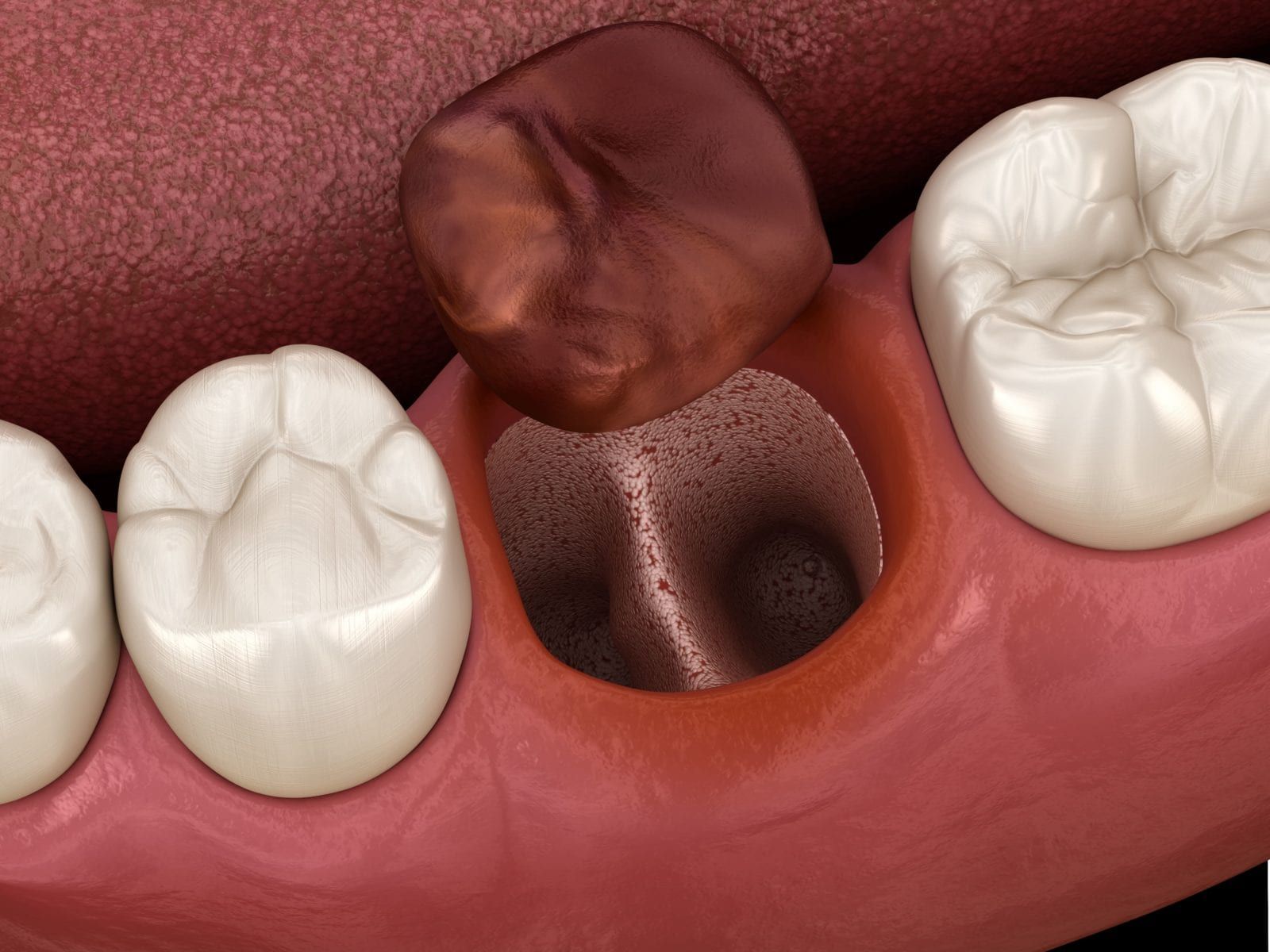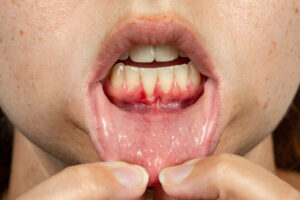Dry Socket: Causes, Symptoms & Treatment

Discover effective prevention and treatment strategies for dry socket, a painful dental condition following tooth extraction. Learn symptoms, causes, and expert tips to speed up recovery and maintain oral health.
Table of Contents
What is Dry Socket?
Dry socket, also known as alveolar osteitis, is a painful dental condition that can occur after a tooth is extracted.
Normally, after a tooth is removed, a blood clot forms in the socket (the hole in the bone where the tooth used to be) to protect the underlying bone and nerves as it heals.
If the blood clot fails to form properly or is dislodged before the wound has healed, the bone and nerves become exposed to air, food, fluid, and bacteria.
This exposure can lead to inflammation and significant pain, not just in the socket but potentially radiating to the ear, eye, temple, or neck on the same side of the face as the extraction.
Dry socket typically develops 2 to 5 days after a tooth is removed and is more common after the extraction of lower wisdom teeth.
It is characterized by a sharp, throbbing pain in the gum or jaw, bad breath, and sometimes an unpleasant taste in the mouth.
While it is a relatively rare complication, certain factors increase the risk of developing dry socket, including smoking, poor oral hygiene, the use of birth control pills, having a history of dry socket, and the complexity of the extraction. CPAP use can also increase the chances of dry socket: Will CPAP Cause Dry Socket?
Dry Socket symptoms
Dry socket presents several distinct symptoms that differentiate it from the normal discomfort following a tooth extraction.
These symptoms typically develop within a few days after the extraction and can include:
- Severe Pain: Unlike the typical post-extraction pain that gradually improves, the pain from dry socket often intensifies and becomes more severe 2 to 3 days after the tooth is removed. This pain can radiate from the socket to your ear, eye, temple, or neck on the same side of your face as the extraction.
- Partial or Total Loss of the Blood Clot: The blood clot that forms in the socket to protect the bone and nerves may be partially or completely lost, leaving the underlying tissues exposed.
- Visible Bone in the Socket: In cases of dry socket, you might be able to see the bone within the socket because the protective blood clot is missing.
- Bad Breath or Foul Odor: The exposed socket can collect food particles and bacteria, leading to bad breath or an unpleasant taste in your mouth, which doesn’t go away with brushing or rinsing.
- Swollen Lymph Nodes: You may experience swelling in the lymph nodes around your neck or jaw area, indicating an inflammatory response.
- Fever: Although less common, some individuals might develop a low-grade fever as a sign of infection.
Experiencing some level of pain and discomfort after a tooth extraction is normal, but if the pain becomes severe, doesn’t improve with pain medication, or is accompanied by the other symptoms mentioned, contact your dentist or oral surgeon.
Dry Socket wisdom teeth
Dry socket is a particularly common complication following the extraction of wisdom teeth, especially the lower wisdom teeth.
Wisdom teeth extractions are more prone to developing dry socket due to their location in the mouth and the complexity of the extraction process, which can sometimes be more traumatic to the surrounding tissues.
This complication arises when the blood clot that forms in the socket to protect the bone and nerves underneath is dislodged or dissolves before the wound has had a chance to properly heal.
Risk Factors Specific to Wisdom Teeth Extractions:
- Surgical Trauma: The extraction of wisdom teeth often requires surgical intervention, which can be more traumatic to the surrounding tissues and bone, increasing the risk of dry socket.
- Location: Lower wisdom teeth are more likely to develop dry socket than upper teeth due to differences in blood supply and the density of the bone.
- Poor Oral Hygiene: Difficulty in maintaining oral hygiene around the extraction site can lead to an increased risk of infection and dry socket.
- Smoking and Tobacco Use: Smoking can inhibit healing and directly affect the formation and maintenance of the blood clot in the socket.
- Previous Dry Socket: Individuals who have experienced dry socket in the past are at a higher risk of developing it again with subsequent extractions.
Dry Socket treatment
Treatment for dry socket focuses on alleviating pain and promoting healing of the socket. Here’s an overview of the typical treatment approach:
Professional Cleaning of the Socket
The first step usually involves the dentist or oral surgeon cleaning the socket to remove any debris or food particles that could be contributing to pain or infection.
Medicated Dressings
After cleaning, a medicated dressing or gauze is often placed in the socket to protect it and reduce pain.
These dressings may contain analgesic, anesthetic, or antiseptic agents to promote comfort and healing. The dressing might need to be replaced every few days in the initial stages of treatment.
Pain Management
Pain relief is a critical component of treating dry socket. Over-the-counter pain relievers like ibuprofen or acetaminophen are commonly recommended. In some cases, stronger prescription pain medication may be necessary.
Topical anesthetics may also be applied directly to the socket or included in the dressing to numb the area.
Antibiotics
If there is evidence of infection or a high risk of developing an infection, antibiotics may be prescribed. Antibiotics are not routinely used for all cases of dry socket, so don’t self-medicate.
Home Care Instructions
Patients are advised on how to care for the socket at home, which includes gentle rinsing with warm salt water or a prescribed antimicrobial mouthwash to promote healing and reduce the risk of further infection.
Avoid smoking, drinking through a straw, or any other suction actions that could dislodge the new clot forming in the socket. If you are on a CPAP machine, don’t use it until your dry socket has been cleared out.
Follow-up Visits
Follow-up visits may be necessary to monitor healing, replace medicated dressings, and ensure that the socket is healing properly.
Self-care Measures
Maintain good oral hygiene, but be gentle around the extraction site to avoid disturbing any new clot formation.
Eat soft foods and avoid the extraction site when chewing, to prevent further irritation.
What does dry socket look like
Dry socket, has a distinctive appearance that differentiates it from the normal healing process of a tooth extraction site.
Here are the key visual indicators of dry socket:
- Lack of a Blood Clot: Normally, after a tooth extraction, a dark-colored blood clot forms in the socket, filling the space where the tooth once was. This clot is crucial for the healing process, as it protects the underlying bone and nerve endings. In the case of dry socket, this clot is either partially or completely missing. Instead of seeing a dark clot, you might see an empty-looking socket or the bone itself.
- Visible Bone: One of the most telling signs of dry socket is the visibility of the bone within the socket. Since the protective blood clot is absent, the white or yellowish bone is exposed to the oral environment.
- Surrounding Tissue: The gum tissue around the socket may appear inflamed and could be redder than the surrounding tissue, indicating irritation or infection. However, significant swelling isn’t always present with dry socket.
- Debris: Because there’s no clot to cover and protect the socket, food particles and debris can accumulate in the area, which can be visible upon examination.
Even if these visual cues can suggest the presence of dry socket, the diagnosis is often made based on symptoms, particularly severe pain that doesn’t improve with standard pain relief measures, bad breath, or an unpleasant taste in the mouth, in addition to the visual aspects.
If you suspect you have dry socket after a tooth extraction, it’s seek dental care promptly.
How to prevent Dry Socket
Preventing dry socket (alveolar osteitis) involves taking steps before and after tooth extraction to protect the blood clot that forms in the socket.
Here are key prevention strategies:
Before Tooth Extraction
- Discuss Risks with Your Dentist: Inform your dentist about your medical history, including any medications you take and whether you smoke, as these factors can affect your risk of developing dry socket.
- Quit Smoking: Smokers have a higher risk of dry socket. Quitting smoking before and after the extraction can significantly reduce this risk.
- Oral Hygiene: Ensure your mouth is as clean as possible before the extraction to reduce the risk of infection, which can contribute to dry socket.
After Tooth Extraction
- Follow Post-Extraction Instructions: Your dentist or oral surgeon will provide specific care instructions. Following these closely is crucial for preventing dry socket.
- Avoid Sucking Motions: Do not use straws, smoke, or spit vigorously after the extraction. These actions can dislodge the blood clot.
- Soft Foods: Eat soft foods for the first few days and avoid chewing on the side of the extraction. Gradually reintroduce solid foods as the extraction site heals.
- Oral Hygiene: Keep your mouth clean to prevent infection. You may be advised to gently rinse your mouth with warm salt water or a prescribed mouthwash after the first 24 hours. Avoid brushing the extraction site directly for the first few days but continue to brush and floss your other teeth.
- Avoid Physical Activity: Reduce physical activity for the first 24 to 48 hours after the extraction to minimize the risk of dislodging the blood clot.
- Pain Management: Use medications as prescribed by your dentist or oral surgeon. Avoid aspirin as it can thin the blood and potentially disrupt clot formation.
- Stay Hydrated: Drink plenty of water to stay hydrated but avoid using a straw.
- Report Any Issues: If you experience severe pain, swelling, or other concerning symptoms after the extraction, contact your dentist or oral surgeon immediately.
By adhering to these preventive measures, you can significantly reduce your risk of developing dry socket and promote a smoother, quicker healing process following a tooth extraction.
FAQ on Dry Socket
Will a dry socket heal on its own?
Yes, a dry socket will eventually heal on its own, but it can be very painful and slow without treatment. Professional care from a dentist or oral surgeon can significantly alleviate pain and accelerate the healing process. Treatment typically involves cleaning the socket, applying medicated dressings to protect it, and managing pain, which helps support the body’s natural healing mechanisms and prevents complications.
What helps dry socket go away?
To help dry socket go away, professional treatment is essential. This includes cleaning the socket to remove debris, applying medicated dressings to alleviate pain and protect the area, and prescribing pain relief medications. You are advised to follow a gentle oral hygiene routine, avoid smoking, and refrain from using straws to prevent further irritation. These measures, combined with rest and following the dentist’s care instructions, promote healing and help resolve dry socket.
When can I stop worrying about dry socket?
You can stop worrying about dry socket typically after the first week following a tooth extraction. The risk of developing dry socket significantly decreases once the initial healing phase has passed and a new blood clot has securely formed in the socket, providing protection to the underlying bone and nerves.
Is dry socket an emergency?
Dry socket is not typically considered a medical emergency, but it does require prompt treatment from a dentist or oral surgeon due to the severe pain and potential for delayed healing it causes. If you suspect you have dry socket, contact your dental professional as soon as possible to alleviate pain and promote proper healing.
Fact Checked
Our dedicated team rigorously evaluates every article and guide to ensure the information is factual, up-to-date, and free of bias.
Updated Regularly
We update our articles and reviews regularly to ensure you have access to the latest data in the dental industry.
The content on Dental3DU’s blog is intended for educational purposes only. This information should not be relied upon as professional medical counsel. Be sure to always consult with your dentist about the dangers and benefits of any medication, treatment or procedure.







